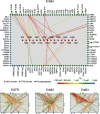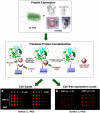Protein microarrays: novel developments and applications
- PMID: 21116694
- PMCID: PMC3137928
- DOI: 10.1007/s11095-010-0325-1
Protein microarrays: novel developments and applications
Abstract
Protein microarray technology possesses some of the greatest potential for providing direct information on protein function and potential drug targets. For example, functional protein microarrays are ideal tools suited for the mapping of biological pathways. They can be used to study most major types of interactions and enzymatic activities that take place in biochemical pathways and have been used for the analysis of simultaneous multiple biomolecular interactions involving protein-protein, protein-lipid, protein-DNA and protein-small molecule interactions. Because of this unique ability to analyze many kinds of molecular interactions en masse, the requirement of very small sample amount and the potential to be miniaturized and automated, protein microarrays are extremely well suited for protein profiling, drug discovery, drug target identification and clinical prognosis and diagnosis. The aim of this review is to summarize the most recent developments in the production, applications and analysis of protein microarrays.
Figures







References
-
- Tomizaki KY, Usui K, Mihara H. Protein-detecting microarrays: current accomplishments and requirements. Chembiochem. 2005;6(5):782–799. - PubMed
-
- Camarero JA. Recent developments in the site-specific immobilization of proteins onto solid supports. Biopolymers. 2008;90(3):450–458. - PubMed
-
- Coleman MA, Hoeprich P, Beernink P, Camarero JA. Cell-free protein expression screening and protein immobilization using protein microarrays. In: Kudlicki W, Katzen F, Bennett R, editors. Cell Free Expression Systems Landes Bioscience Publishers; 2007.
Publication types
MeSH terms
Substances
Grants and funding
LinkOut - more resources
Full Text Sources
Other Literature Sources
Research Materials

